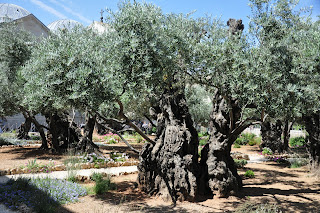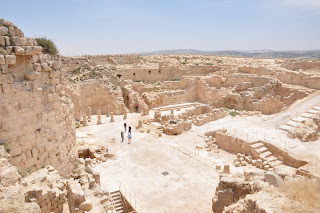
Working on maps while gazing out on the valleys and hills
Anathoth, the birthplace and home of the prophet Jeremiah. It makes sense, then, why Jeremiah would use so much wilderness imagery and often fondly.
Poor Stewie didn’t feel so well.
While there may not appear to be many positives about the east, especially geographically, the people from this section of land are impressively tough. These people have been able to survive—and, in fact, thrive—on powdery, arid land, with only very sparse tufts of grass for livestock to graze on. Everyday when they go out with their livestock, they risk their lives to robbers, ruffians, and rebels; and this is the place to which those in exile flee (i.e. David during Absalom’s coup).
Given the differences in the land and demographics between the east and the west, it is not surprising there is lots of tension between the two. The west is especially suspicious of the east. However, they are co-dependent, because while farmers in the west provide for the nation’s agricultural needs, the shepherds in the east provide meat, milk, and other animal products.
An ancient tomb, like one Lazarus would have been buried in.
Nick, from the Western Seminary group
"You're actually going to crawl in there??"
"ABSOLUTELY."
Solomon and Jon in the mini-cave behind the burial niches.
The first thing Lazarus saw after he was brought back to life. =P
CIU: Represent
Looking out at Jerusalem from inside a church on the Mt. of Olives
Carving names on cacti instead of tree trunks?
The happiest little Greek Orthodox priest I have seen yet, practically bouncing down the hill
And then he decided to solicit the help of a random kind tourist.
At the Garden of Gethsemane, we saw olive trees dating back to the time of Jesus, as well as possibly one of the most beautiful churches I have seen. (It’s a personal favorite, at least.)
Can you believe this tree dates back 1,500-2,000 years ago?
Inside the church: I love the colors and design—unlike any other church I’ve seen before.
How awesome would it be to have this door panel in your room at home?
The front side of the church
The East Gate closed off
The cemetery leading east to Jerusalem
Pause for a picture!
Our next stop was the Herodium, a large hill on the West Bank where Herod built one of his residential palaces. After he died, they closed off the palace so that no one else could reside there. Herod himself was a controversial governor. The personification of syncretism of his day, he was part Jewish, part Roman, and Hasmonean--he was Jewish, but not really. He was tyrannical, and paranoid, but very good at his job. Therefore, the Jewish people hated him, but Rome loved him.
Looking down at the palacial ruins
Following along with Aubrey on the maps
Mayonne, stylin' it in her shades
Looking down on the land from the Herodium also revealed a lot of context for certain biblical passages. For example, Psalm 23 looks completely different from the land than in my mind's eye. Green pastures? These are the occasional tufts of green grass interspersed throughout the dusty Senonian hills. Still waters? The only water nearby are the wadis, which are usually dry, but sweep people away every year with their unexpected current when they are filled. Therefore, still waters are a big deal. This is, like I said, the land of robbers, ruffians, and rebels, so the peace and protection of the Lord was tangibly significant. What about the table? According to Aubrey, the staple food of the shepherds back then was a kind of yogurt that was preserved in a way it could last for two years! A full meal prepared at a table, then, was a HUGE deal!
Check out the three-rowed Mercedes taxi!
Finally, we concluded our very looong day (and subsequently, this very looong post) with a visit to Bethlehem. What first caught the American eye?
Stars & Bucks!
At the church marking where it is claimed Christ was born, I met Miguel. No larger than a 7-year old with contorted limbs, he sat on his bike in the courtyard holding out a little card in English that explained his condition. Turns out Miguel is from Barcelona, and he's been here in Bethlehem for the last two years. After just a brief conversation with him in Spanish about Spain, I couldn't stop thinking about Miguel for the rest of the day. Why do people like him with crippling disabilities have to feed themselves by begging? He was such a sweet man. There's so much more he could do with his life, despite being disabled. Granted, I don't know his entire story, but what happened to coming alongside the needy to free them up for a purposeful existence? There's only so much I can do for Miguel in this given situation. Nevertheless, I can pray for him and others like him, that they will be blessed by the Lord and others.
Again, I apologize for the length of this post, but considering the length of our first full day in the field, perhaps you can pardon me for the magnitude of a mere fraction. I would like to conclude, though, with a quick tribute to the man who will exist for the next three weeks in nothing but orange and khaki:
Just saying, this man is a riot to travel with. =D
































Wow! You sure are getting a lot out of this trip. I can't wait to hear your other thoughts on the land and things from the Bible about it. Psalm 23 is definitely becoming more real alive to me as you describe thing. =)
ReplyDeleteI can't believe you climbed into that tomb.
ReplyDeleteThere was a sad lack of cats in this post ;)
ReplyDeleteI'm intrigued by the state of obvious denial they must have been in to justify closing off the east gate. It's hard to wrap my mind around the thought process that would lead to that...They'd have to believe that He could come back in order for them to have gone through the trouble of "preventing" it. If He is powerful enough to come back, then who is He? Then the self righteousness of putting a cometary there to make him "unclean."
ReplyDeletep.s. the initials in the cactus thing was pretty funny. I guess somethings are just universal. ;)
Mt. of Olives is a pretty amazing spot, isn't it? Actually, the Jews are longing for the Messiah to come (they just believe this will be His first coming). I believe the Arabs are the ones who blocked off the Eastern gate, knowing the Jewish prophecies, and also the cemetery right there is highly coveted by the Jews (and very expensive) because if they are buried there, they will be the first to be resurrected at Messiah's coming!!
ReplyDelete